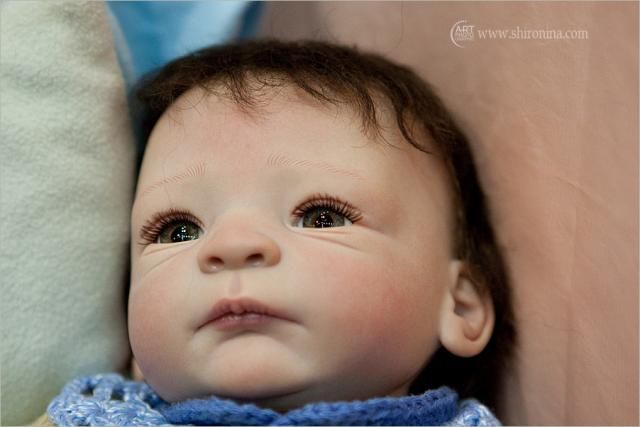|
|
International Doll Salon, Moscow, Russia
|
African dolls are used to teach, and entertain, they are supernatural intermediaries, and they are manipulated for ritual purposes. Their shape and costume vary according to region and custom. Frequently dolls are handed down from mother to daughter. Akuaba are wooden ritual fertility dolls from Ghana and nearby areas. The best known akuaba are those of the Ashanti people, whose akuaba have large, disc-like heads. Other tribes in the region have their own distinctive style of akuaba.
There is a rich history of Japanese traditional dolls dating back to the Dogū figures (8000-200 BC) and Haniwa funerary figures (300-600 AD). By the eleventh century dolls were used as playthings as well as for protection and in religious ceremonies. During Hinamatsuri, the doll festival, hina dolls are displayed. These are made of straw and wood, painted, and dressed in elaborate, many-layered textiles. Daruma dolls are spherical dolls with red bodies and white faces without pupils. They represent Bodhidharma, the East Indian who founded Zen, and are used as good luck charms. Wooden Kokeshi dolls have no arms or legs, but a large head and cylindrical body, representing little girls.
The use of an effigy to perform a spell on someone is documented in African, Native American, and European cultures. Examples of such magical devices include the European poppet and the nkisi or bocio of West and Central Africa. In European folk magic and witchcraft, poppet dolls are used to represent a person, for casting spells on that person. The intention is that whatever actions are performed upon the effigy will be transferred to the subject based in sympathetic magic. The practice of sticking pins in so called voodoo dolls have been associated with African-American Hoodoo folk magic. Voodoo dolls are not a feature of Haitian Vodou religion, but have been portrayed as such in popular culture, and stereotypical voodoo dolls are sold to tourists in Haiti. Likely the voodoo doll concept in popular culture is influenced by the European poppet dolls. A kitchen witch is a poppet originating in Northern Europe. It resembles a stereotypical witch or crone and is displayed in residential kitchens as a means to provide good luck and ward off bad spirits.
Hopi Kachina dolls are effigies made of cottonwood that embody the characteristics of the ceremonial Kachina, the masked spirits of the Hopi Native American tribe. Kachina dolls are objects meant to be treasured and studied, in order to learn the characteristics of each Kachina. Inuit dolls are made out of soapstone and bone, materials common to the Inuit people. Many are clothed with animal fur or skin. Their clothing articulates the traditional style of dress necessary to survive cold winters, wind, and snow. The tea dolls of the Innu people were filled with tea for young girls to carry on long journeys. Apple dolls are traditional North American dolls with a head made from dried apples. In Inca mythology Sara Mama was the goddess of grain. She was associated with maize that grew in multiples or were similarly strange. These strange plants were sometimes dressed as dolls of Sara Mama. Corn husk dolls are traditional Native American dolls made out of the dried leaves or husk of a corncob. Traditionally they do not have a face. The making of corn husk dolls was adopted by early European settlers in the USA. Early settlers also made rag dolls and carved wooden dolls, called Pennywoods. La última muñeca, or "the last doll", is a tradition of the Quinceañera, the celebration of a girl's fifteenth birthday in parts of Latin America. During this ritual the quinceañera relinquishes a doll from her childhood to signify that she is no longer in need of such a toy. In the United States, dollmaking became an industry in the 1860s, after the Civil War.
|
|









